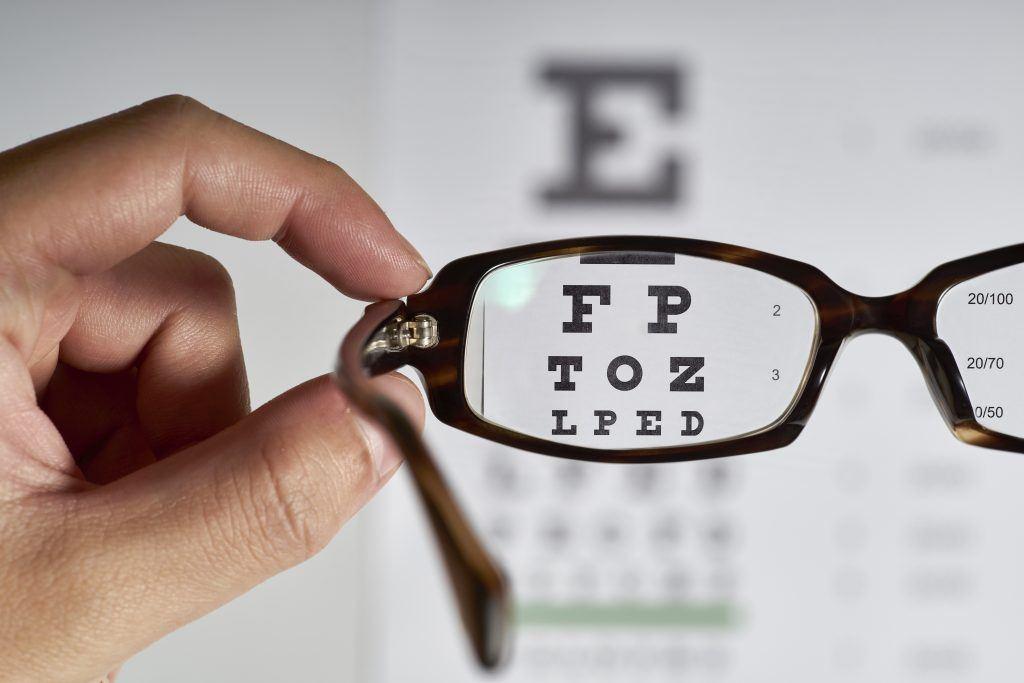Why Do People Need Glasses/Contacts?
Sub Title

People need glasses or contacts because of a common problem called refractive error, which blurs vision. There are four different types of refractive error: nearsightedness, farsightedness, astigmatism, and presbyopia. Nearsightedness and farsightedness are always mutually exclusive, but astigmatism and presbyopia may occur alone, with each other, and with nearsightedness or farsightedness. In order to understand refractive error, one needs to think of the eye as acting like a camera. The cornea (the transparent window forming the front of the eye) and the eye’s natural lens act like the lens of a camera to focus light onto the retina in the back of the eye. The retina functions like the film of a camera by receiving light images and translating them into electrical impulses that are transmitted to the brain and interpreted as vision. Patients who have no refractive error and do not need glasses or contacts to see perfectly have a perfect balance between the curvature of the front part of the eye (primarily the cornea) and the length of the eye, so that light images focus sharply on the retina. In the normal eye, close images can be focused on the retina by increasing the power of the natural lens through accommodation, which is the ability of the eye to change its focus between distant objects and near objects.
Nearsightedness
Nearsightedness (myopia) is the most common refractive error, affecting approximately 40% of the population of the United States. Nearsightedness occurs because the eye is too long or the cornea is too steep, resulting in blur (because images are brought into focus in front of the retina). Without corrective lenses, nearsighted people (in medical terminology, myopes) can see things up close but not far away. Myopia is treated surgically by decreasing the focusing power of the eye by flattening the cornea (LASIK/PRK) or by adding a negatively powered lens (ICL/IOL).
Farsightedness
Farsightedness (hyperopia) is also a common refractive error that requires glasses or contact lenses to correct. Farsightedness occurs because the eye is too short or the cornea is too flat, resulting in blur (because images are brought into focus behind the retina). When farsighted people have accommodation of their lens during their younger years, they can see up close and distantly without correction. As they age, hyperopes (people who are farsighted) first lose their reading vision (which takes the most accommodation), then their intermediate vision (computer) and, finally, their distance vision, requiring glasses or contacts. Because hyperopes maintain distance vision until they get older, the condition is called “farsightedness.” This familiar term for hyperopia is confusing, however, because hyperopes eventually lose their ability to see distance without glasses as they get older. Younger patients with significant hyperopia require glasses for far and near vision if their level of hyperopia is so high that their accommodative mechanism (zooming power of the natural lens) is not strong enough to compensate. Hyperopia is treated surgically by increasing the focusing power of the eye by steepening the cornea (LASIK/PRK) or adding a positively powered lens (ICL/IOL).
Astigmatism
Astigmatism is a refractive error that blurs vision at all distances because of two different curvatures of the cornea, causing two different images of light from a single light source, neither of which is in focus on the retina. Astigmatism can occur as an isolated visual challenge or in conjunction with nearsightedness or farsightedness. An eye without astigmatism has the same corneal curvature in each direction; to visualize this, think of a nonastigmatic cornea looking like a basketball cut in half. In contrast, an astigmatic cornea is shaped more like a football cut in half, with one direction steep,the other flat. Astigmatism is treated surgically by steepening the cornea in the flat axis and/or flattening the cornea in the steep axis (LASIK/PRK) or adding a lens that is positively powered in the flat axis (ICL/IOL).
Presbyopia
Presbyopia, is a refractive error that eventually plagues every human being who lives long enough to experience this age-related loss of zooming (or focusing) power in the lens, requiring reading glasses (for people with no other refractive error) or bifocals (in patients that have nearsightedness, farsightedness, or astigmatism). Presbyopia usually begins between the ages of forty-two to forty-seven because of the loss of accommodation. Eye doctors often joke that there are three facts of life: death, taxes, and presbyopia! Patients in their fifties, sixties, or seventies who claim that they have never needed glasses for distance or near visual acuity are still presbyopic, but they do not notice it, either because they have natural monovision (one eye set for distance, the other for near), or they have a low degree of nearsightedness in both eyes, which allows them to read; consequently, they have gotten used to the distance blur and do not realize that their distance is not perfect. Presbyopia and the loss of vision with age (due to farsightedness) both occur because of loss of accommodation, but they are distinct entities that are commonly confused. Presbyopia alone results strictly from the loss of accommodation in an eye that has a perfect balance between the curvature of the cornea and length of the eye and requires glasses for reading only; hyperopia results from an eye that is too short or a cornea that is too flat. In hyperopia, glasses are at first needed for reading (due to presbyopia), but eventually required for distance as well. Presbyopia is treated with reading glasses, monovisionLASIK/PRK or ICL or with presbyopic IOLs (accommodative or multi-focal).

